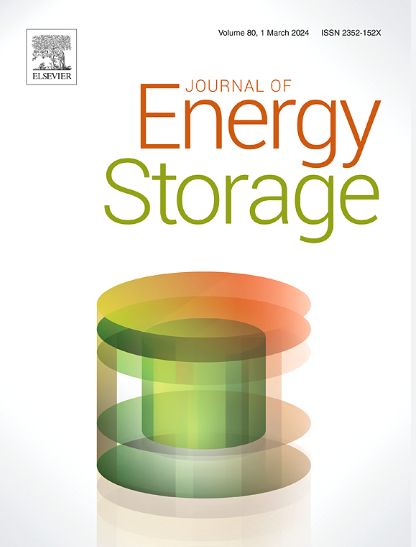Solvent-tethered strategy enables the eutectogel integrated electrode with high conductivity and low-temperature resistance applying for supercapacitors
IF 8.9
2区 工程技术
Q1 ENERGY & FUELS
引用次数: 0
Abstract
As demand for wearable electronic devices grows, developing flexible supercapacitors with gel electrolytes has become imperative. To address the low conductivity and poor low-temperature resistance of conventional gel electrolytes, herein, a novel solvent-tethered strategy is proposed and the in-situ polymerization is employed to prepare the eutectogel integrated electrode with high conductivity and low-temperature resistance. Specifically, glycerol (GLy) is incorporated as a tether to bind with acrylic acid (AA, hydrogen bond donor), thus allowing it easier for the quaternary ammonium cations (Ch+) of the choline chloride (ChCl, hydrogen bond acceptor) to migrate, thereby improving the ionic conductivity. Theoretical validation via density functional theory confirms the feasibility of this strategy. The resulting eutectogel electrolyte (CAG-1.2) exhibits a high conductivity of 17.0 mS cm−1 at room temperature and remains unfrozen at −90 °C. Moreover, the symmetrical electrode supercapacitor based on CAG-1.2 delivers a specific capacitance of 170 F g−1 and demonstrates remarkable cycling stability over 40,000 cycles, operating effectively even in extreme environments. This strategy provides a new theoretical reference for designing high-performance flexible electronic devices.
溶剂系固策略使共晶集成电极具有高导电性和耐低温性,适用于超级电容器
随着可穿戴电子设备需求的增长,开发具有凝胶电解质的柔性超级电容器已势在必行。针对传统凝胶电解质电导率低、耐低温性差的问题,提出了一种新型的溶剂系固策略,采用原位聚合法制备了具有高电导率和耐低温性能的共聚乙二醇集成电极。具体来说,将甘油(GLy)作为系绳与丙烯酸(AA,氢键供体)结合,从而使氯化胆碱(ChCl,氢键受体)的季铵离子(Ch+)更容易迁移,从而提高离子电导率。通过密度泛函理论验证了该策略的可行性。得到的共析电解质(CAG-1.2)在室温下具有17.0 mS cm -1的高电导率,在- 90℃下保持不冻结。此外,基于CAG-1.2的对称电极超级电容器提供170 F g−1的比电容,并在40,000次循环中表现出卓越的循环稳定性,即使在极端环境下也能有效运行。该策略为设计高性能柔性电子器件提供了新的理论参考。
本文章由计算机程序翻译,如有差异,请以英文原文为准。
求助全文
约1分钟内获得全文
求助全文
来源期刊

Journal of energy storage
Energy-Renewable Energy, Sustainability and the Environment
CiteScore
11.80
自引率
24.50%
发文量
2262
审稿时长
69 days
期刊介绍:
Journal of energy storage focusses on all aspects of energy storage, in particular systems integration, electric grid integration, modelling and analysis, novel energy storage technologies, sizing and management strategies, business models for operation of storage systems and energy storage developments worldwide.
 求助内容:
求助内容: 应助结果提醒方式:
应助结果提醒方式:


